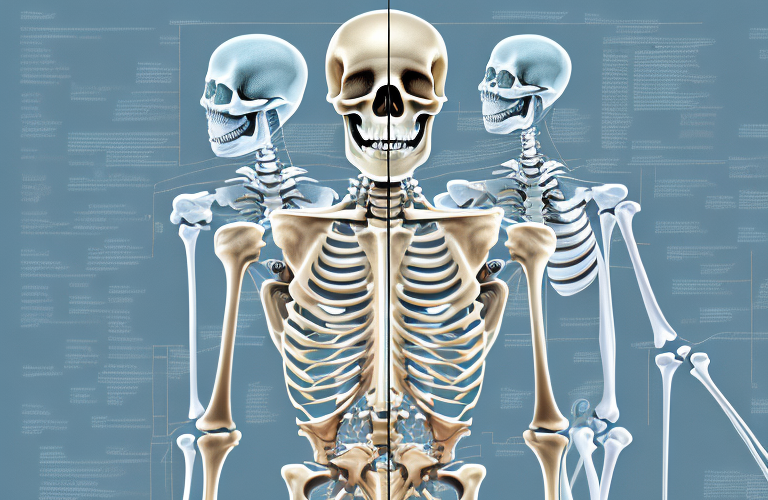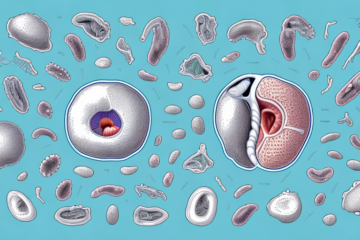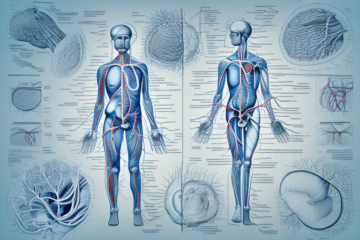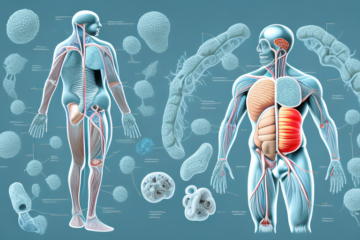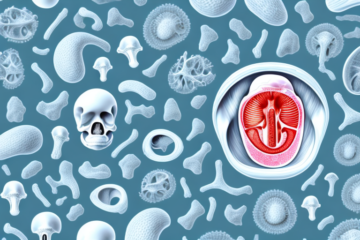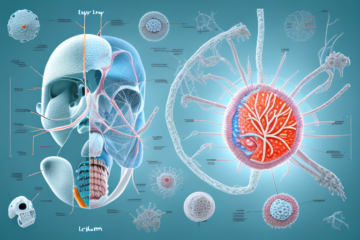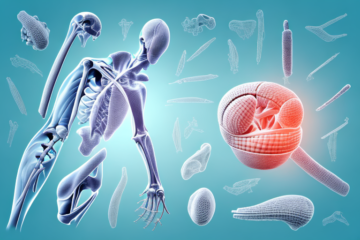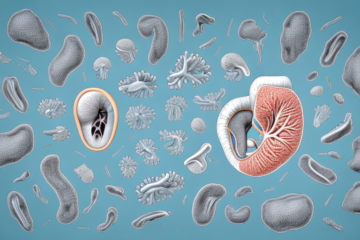Joints are complex structures in the human body that enable movement and mobility. They connect bones, cartilage, ligaments, and tendons to each other and work together to provide support, stability, and flexibility. Understanding the different types of joints, their anatomy, and function is essential to maintaining joint health and preventing injuries.
Types of Joints: Understanding the Differences
The human body contains three main types of joints: synovial joints, cartilaginous joints, and fibrous joints. Synovial joints, which are the most common type, are freely movable and allow for extensive motion. The hinge joint in the elbow and the ball-and-socket joint in the hip are examples of synovial joints. Cartilaginous joints, on the other hand, are connected by cartilage and are less flexible than synovial joints. Examples of these joints include the vertebrae in the spine. Fibrous joints are the most rigid and are made up of tough connective tissue. The sutures in the skull are an example of a fibrous joint.
It is important to note that joints can also be classified based on their function. Some joints, such as the knee joint, are designed for stability and weight-bearing, while others, such as the shoulder joint, prioritize mobility and range of motion. Understanding the different types and functions of joints can help individuals better understand their own body and how to properly care for their joints through exercise and injury prevention.
The Importance of Joint Health: Maintaining Mobility and Flexibility
Joints play a vital role in the human body, allowing us to move, exercise, and perform daily activities with ease. However, as we age, our joints may become stiffer and less mobile, leading to discomfort, pain, and even disability. Maintaining joint health through exercise, a healthy diet, and good posture can help prevent joint problems and maintain mobility and flexibility.
In addition to exercise, diet, and posture, there are other ways to maintain joint health. One such way is through the use of supplements, such as glucosamine and chondroitin, which have been shown to improve joint function and reduce pain in some individuals. It is important to consult with a healthcare professional before starting any new supplement regimen.
Common Joint Injuries and How to Prevent Them
Sports injuries, falls, and trauma can all cause joint injuries such as dislocations, fractures, and sprains. Preventing joint injuries involves taking precautions such as wearing proper protective gear when playing sports, using proper lifting techniques, maintaining a healthy weight, and exercising regularly to keep joints strong and flexible.
It is important to note that certain medical conditions can also increase the risk of joint injuries. For example, individuals with osteoporosis have weaker bones and are more prone to fractures. Those with rheumatoid arthritis may experience joint pain and inflammation, which can lead to joint damage over time. It is important for individuals with these conditions to work closely with their healthcare provider to manage their condition and reduce the risk of joint injuries.
In addition to preventative measures, proper treatment of joint injuries is crucial for a full recovery. This may include rest, ice, compression, and elevation (RICE), physical therapy, and in some cases, surgery. It is important to seek medical attention if you suspect a joint injury, as early treatment can help prevent further damage and improve outcomes.
Arthritis: Symptoms, Causes, and Treatment Options
Arthritis is a condition characterized by inflammation and pain in the joints. It can affect any joint in the body and can make movement difficult and painful. Common symptoms of arthritis include joint stiffness, pain, and swelling. Treatment options for arthritis include medication, exercise, physical therapy, and lifestyle changes such as dietary modifications and weight management.
There are several different types of arthritis, including osteoarthritis, rheumatoid arthritis, and psoriatic arthritis. Osteoarthritis is the most common type and is caused by wear and tear on the joints over time. Rheumatoid arthritis is an autoimmune disorder in which the body’s immune system attacks the joints, causing inflammation and pain. Psoriatic arthritis is a type of arthritis that occurs in people with psoriasis, a skin condition characterized by red, scaly patches.
The Role of Hyaluronic Acid in Joint Health
Hyaluronic acid is a natural substance found in the body that helps lubricate and cushion joints. As we age, hyaluronic acid levels may decrease, leading to joint stiffness and pain. Supplementing with hyaluronic acid or receiving injections of the substance can help improve joint health and reduce pain and discomfort.
In addition to its role in joint health, hyaluronic acid also plays a crucial role in skin health. It is a key component of the skin’s extracellular matrix, helping to maintain hydration and elasticity. As we age, our skin’s natural production of hyaluronic acid decreases, leading to dryness, wrinkles, and sagging. Topical application of hyaluronic acid can help improve skin hydration and reduce the appearance of fine lines and wrinkles.
Furthermore, hyaluronic acid has been shown to have anti-inflammatory properties, making it a potential treatment for conditions such as osteoarthritis and inflammatory bowel disease. It may also have a role in wound healing, as it helps to promote tissue regeneration and reduce inflammation at the site of injury.
Benefits of Exercise for Joint Health and Function
Regular exercise is essential for maintaining joint health and function. Engaging in low-impact activities such as walking, swimming, and yoga can help strengthen the muscles around the joints and improve flexibility and range of motion. However, it’s essential to consult a doctor before starting any exercise regimen to rule out any underlying joint problems.
In addition to improving joint health and function, exercise can also help manage joint pain and inflammation. Studies have shown that regular exercise can reduce pain and stiffness in individuals with arthritis and other joint conditions. This is because exercise helps to increase blood flow to the joints, which can reduce inflammation and promote healing.
Furthermore, exercise can also have a positive impact on mental health. Engaging in physical activity releases endorphins, which are natural mood-boosters. This can help reduce stress and anxiety, which are often associated with chronic joint pain and other health conditions. Additionally, exercise can provide a sense of accomplishment and improve self-esteem, which can further enhance overall well-being.
Natural Remedies for Joint Pain and Inflammation
Natural remedies such as turmeric, ginger, and omega-3 fatty acids may help reduce joint pain and inflammation. These natural supplements can be added to the diet or taken in supplement form, but it’s important to consult a doctor before taking any new supplements, especially if currently taking any medications.
In addition to natural supplements, regular exercise and maintaining a healthy weight can also help alleviate joint pain and inflammation. Low-impact exercises such as swimming, yoga, and walking can improve joint flexibility and reduce stiffness. Eating a balanced diet with plenty of fruits, vegetables, and lean protein can also support joint health.
Foods that Promote Joint Health
Eating a diet rich in nutrients such as calcium, Vitamin D, and antioxidants can help promote joint health and reduce the risk of joint problems. Foods such as leafy greens, fatty fish, and nuts can help keep joints healthy and strong.
In addition to these foods, incorporating turmeric into your diet can also be beneficial for joint health. Turmeric contains a compound called curcumin, which has anti-inflammatory properties that can help reduce joint pain and stiffness. You can add turmeric to your meals or take it as a supplement to reap its benefits.
Surgery for Joint Repair: Understanding Your Options
Surgery may be necessary to repair joints that are damaged or injured. However, surgery should always be considered a last resort after all other treatments have been exhausted. Various surgical options are available, such as joint replacement surgery and arthroscopy. A doctor will recommend the best course of action based on the patient’s specific needs and circumstances.
It is important to note that surgery for joint repair can come with risks and potential complications. Patients should discuss these risks with their doctor and make an informed decision about whether surgery is the right choice for them. Additionally, post-operative care and rehabilitation are crucial for a successful outcome. Patients should follow their doctor’s instructions carefully and attend all recommended physical therapy sessions to ensure proper healing and recovery.
How to Choose the Right Shoes for Optimal Joint Support
The shoes a person wears can greatly impact joint health and function. It’s important to choose shoes that fit properly and offer appropriate support for the specific activity being performed. For example, running shoes should be chosen for jogging and athletic activities rather than casual walking shoes.
When selecting shoes for optimal joint support, it’s also important to consider the type of surface you’ll be walking or running on. Shoes with good shock absorption are ideal for hard surfaces like concrete, while shoes with good traction are important for slippery surfaces like wet pavement or trails.
In addition to choosing the right shoes, it’s also important to replace them regularly. Over time, shoes lose their cushioning and support, which can lead to joint pain and injury. As a general rule, running shoes should be replaced every 300-500 miles, or every 6-8 months for regular runners.
The Connection Between Diet and Joint Health
The foods a person eats can affect joint health in many ways. Consuming foods high in sugar and saturated fat can promote inflammation and lead to joint pain and stiffness. Eating a diet rich in fruits, vegetables, and lean proteins can help minimize inflammation and support joint health.
In addition to diet, regular exercise is also important for maintaining healthy joints. Exercise helps to strengthen the muscles around the joints, which can help to reduce the pressure on the joints themselves. Low-impact exercises such as swimming, cycling, and yoga are particularly beneficial for joint health. It is also important to maintain a healthy weight, as excess weight can put additional strain on the joints and increase the risk of joint damage and pain.
Yoga Poses to Improve Joint Flexibility and Mobility
Yoga is an excellent way to improve joint flexibility and mobility. Various yoga poses such as the downward-facing dog and the warrior can help stretch and strengthen the muscles around the joints, improving their overall health and functioning.
In addition to improving joint flexibility and mobility, practicing yoga regularly can also help reduce stress and anxiety levels, improve balance and coordination, and increase overall physical strength and endurance. It is a low-impact form of exercise that can be beneficial for people of all ages and fitness levels.
Topical Treatments for Arthritis Pain Relief
Topical treatments such as creams and gels can provide relief from arthritis pain and inflammation. These products contain ingredients such as menthol and capsaicin, which work to numb pain and promote blood flow to the affected joint. However, it’s important to use these products as directed and consult a doctor before starting any new treatment.
It’s also worth noting that topical treatments may not be effective for everyone and may not provide long-term relief. In some cases, oral medications or injections may be necessary to manage arthritis symptoms. Additionally, it’s important to maintain a healthy lifestyle with regular exercise and a balanced diet to support joint health and overall well-being.
The Future of Joint Replacement Surgery: Advancements in Technology
The advancements in medical technology have made joint replacement surgery safer and more effective than ever before. With the use of 3D printing and robotic technology, surgeons can create custom implants and perform surgeries with greater precision and accuracy, leading to faster recoveries and better outcomes.
Overall, understanding the different types of joints, the importance of joint health, and how to maintain joint function is crucial for overall health and well-being. By incorporating healthy habits and early intervention, joint problems can be prevented and managed, helping to support a long and active life.
One of the most exciting advancements in joint replacement surgery is the use of stem cells. Stem cells have the ability to regenerate damaged tissue and can be used to repair and regrow cartilage in joints. This technology is still in its early stages, but has the potential to revolutionize the way joint problems are treated in the future.

